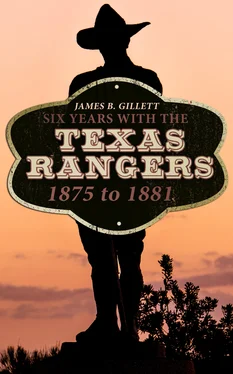James B. Gillett - Six Years With the Texas Rangers - 1875 to 1881
Здесь есть возможность читать онлайн «James B. Gillett - Six Years With the Texas Rangers - 1875 to 1881» — ознакомительный отрывок электронной книги совершенно бесплатно, а после прочтения отрывка купить полную версию. В некоторых случаях можно слушать аудио, скачать через торрент в формате fb2 и присутствует краткое содержание. Жанр: unrecognised, на английском языке. Описание произведения, (предисловие) а так же отзывы посетителей доступны на портале библиотеки ЛибКат.
- Название:Six Years With the Texas Rangers: 1875 to 1881
- Автор:
- Жанр:
- Год:неизвестен
- ISBN:нет данных
- Рейтинг книги:3 / 5. Голосов: 1
-
Избранное:Добавить в избранное
- Отзывы:
-
Ваша оценка:
- 60
- 1
- 2
- 3
- 4
- 5
Six Years With the Texas Rangers: 1875 to 1881: краткое содержание, описание и аннотация
Предлагаем к чтению аннотацию, описание, краткое содержание или предисловие (зависит от того, что написал сам автор книги «Six Years With the Texas Rangers: 1875 to 1881»). Если вы не нашли необходимую информацию о книге — напишите в комментариях, мы постараемся отыскать её.
Six Years With the Texas Rangers: 1875 to 1881 — читать онлайн ознакомительный отрывок
Ниже представлен текст книги, разбитый по страницам. Система сохранения места последней прочитанной страницы, позволяет с удобством читать онлайн бесплатно книгу «Six Years With the Texas Rangers: 1875 to 1881», без необходимости каждый раз заново искать на чём Вы остановились. Поставьте закладку, и сможете в любой момент перейти на страницу, на которой закончили чтение.
Интервал:
Закладка:
For years cattle had drifted south into Menard and Kinible Counties, and Joe Franks was one of the first of the Coleman County outfits to go south into the San Saba and Llano country. He worked the Big and Little Saline Creeks, the Llano and San Saba Rivers and found many of his cattle down there. By the last of November he had about finished work for the year, and, gathering three hundred fat cows to drive to Calvert, Texas, he left John Banister down on the Big Saline to winter the horses.
I passed through Lampasas with these cows, and saw my mother and sisters for the first time in nine months. When we reached Bell County a cow buyer met us and bought the cows at $10 per head. He just got down off his horse, lifted a pair of saddle bags off and counted out three thousand dollars in twenty dollar gold pieces, and hired some of the boys to help him drive the cattle into Calvert. Mr. Franks, with most of the outfit, turned back to Lampasas. When he settled with me Mr. Franks owed me just $200, and he handed me ten twenty dollar gold pieces. It was the most money I had ever earned and almost the greatest amount I had seen in my life.
I spent December and January at home, and early in February, 1874, I started back to Menard County with Mr. Franks, as he was anxious to begin work as early in the spring as possible. When we reached Parsons Ranch on the Big Saline we learned that the Indians had stolen all his horses,—seventy-five or eighty head, and he had left only eight or ten old ponies. Mr. Franks sent Will Banister and myself back to Coleman County to pick up ten or twelve horses he had left there the year before, while he himself returned to Lampasas and Williamson Counties to buy horses.
This trip from Menard County to Coleman County, a distance of about one hundred and fifty miles, was rather a hazardous trip for two boys to make alone. However, we were both armed with new Winchesters and would have been able to put up a stiff fight if cornered. Our ponies were poor and weak, so that it would have been impossible for us to have escaped had we met a band of Indians. And this is what we came very near doing.
There was no road from Menard to Coleman at that time, so we just traveled north. I had cow hunted over most of that country the year before and knew by landmarks pretty well how to go. We reached the head of Big Brady Creek one evening while a cold north wind was blowing. We camped for the night right down in the bed of a dry creek to get out of the wind. We saddled up next morning and had not gone more than a hundred and fifty yards from camp before we discovered where sixteen or seventeen Indians had just gone along,— at least there was that number of pony tracks. These redskins had hopped a skunk, gotten down and killed it with a chunk of wood. When we found the body it had scarcely quit bleeding. We saw moccasin tracks as if the savages had all gotten off their ponies for a few moments. Banister and I made the trip safely, and returned to Menard County early in March. Mr. Franks soon came with a new bunch of horses, and we went right to work gathering and delivering cattle.
About the first of June, Bee Clayton came to the outfit from Lampasas County and told me my father had been dead more than a month. Mr. Franks settled with me and I started for home the next day. Upon reaching Lampasas I began work with Barrett and Nicholls' outfit. They were the biggest cattle owners in that country and ran three large outfits, one in Llano County, one in San Saba County, and another in Lampasas. I worked with the last mentioned outfit that I might be near my mother and sisters.
I had now become familiar with most aspects of frontier life. I had cow punched and seen Indian raids, but I had not yet met the Texas "bad man"— the murderer and the bandit. My education was not long neglected, for it was while working with Barrett and Nicholls that I made my acquaintance with gentry of that ilk. One day five or six of our boys were sitting down in a circle eating on a side of calf ribs. One of the men, Jack Perkins, suddenly became involved in an altercation with Levi Dunbar, and, without warning, jerked out his six-shooter and shot him to death. In rising to my feet I had my right shoulder powder burned.
I stayed with Barrett and Nicholls until they quit work about December 1, 1874. In those days cattle were not worked much in the winter months, so I spent the winter at home. By spring I had become as restless as a bear and longed to get back to the frontier. Finally I could stand the idleness no longer and told my mother I was going back to Menard County to work for Mr. Franks. I reached the town of Menardville early in March, 1875. There I learned that Joe Franks was then at work on South Llano in Kimble County, about sixty miles from Menard. Wess Ellis had just bought the Rufe Winn stock of cattle and was ready to start on a cow hunt. He wanted me to work for him, declaring he could pay me as much as Joe Franks or anybody else, so I hired to him for $30 a month,—the top wages for a cowboy at that time. During the year I was at home a company of Texas Rangers commanded by Captain Dan W. Roberts had been stationed over on Little Saline. This company received its mail at Menardville, and I became acquainted with this famous organization. Their free, open life along the frontier had fired me with longing to become one of them and join in their adventurous lives. In the spring of 1875 the Governor of Texas authorized Captain Roberts to increase his command to fifty men. Almost immediately Captain Roberts announced in Menardville and vicinity that he would enlist twenty good men on June 1st to bring his company to full strength. Here was my opportunity, and I decided I would be one of those twenty recruits.
CHAPTER II
THE TEXAS RANGERS
Table of Contents
The Texas Rangers, as an organization, dates from the spring of 1836. When the Alamo had fallen before the onslaught of the Mexican troops and the frightful massacre had occurred, General Sam Houston organized among the Texan settlers in the territory a troop of 1600 mounted riflemen. This company, formed for the defense of the Texan borders, was the original Texas Ranger unit, and it is interesting to note that the organization from its very inception to the present moment has never swerved from that purpose—the protection of Texan borders, whether such protection be against the Indian, the bandit or marauding Mexicans from beyond the Rio Grande. This little troop of rangers won everlasting laurels in its stand against Santa Anna at the battle of San Jacinto.
When the Republic of Texas was organized in December, 1837, the new state found herself with an enormous frontier to protect. To the south was the hostile Mexico while to the west and northwest roved the Indian and the bandit. To furnish protection against such enemies and to form the nucleus of a national standing army the ranger troop was retained. During the seven years that Texas had to maintain her own independence before she was admitted into the American Union, her rangers repelled hordes of Mexicans, fought the murderous Apaches, Comanches, and Kiowas, and administered justice on a wholesale plan to a great number of outlaws and ruffians that had flocked pell mell into the new Republic from the less attractive parts of the United States.
So vital was the service rendered by the rangers in protecting the lives and property of the settlers along the frontiers of the state that Texas retained twelve hundred rangers as mounted police for patrol of the Mexican border and as a safeguard against the savage redskins of the southwest. When the Civil War broke out between the North and the South, Texas was drawn into the conflict on the side of the Confederacy. General Con Terry, an old ranger, organized the famous body of men known as Terry's Texas Rangers. This command was composed almost exclusively of ex-rangers and frontiersmen. From Bull Run to Appomattox this ranger troop rendered gallant service, and lost seventy-five per cent of its original muster roll. General Sherman, in his memoirs, speaks admiringly of the bravery of the rangers at the battle of Shiloh.
Читать дальшеИнтервал:
Закладка:
Похожие книги на «Six Years With the Texas Rangers: 1875 to 1881»
Представляем Вашему вниманию похожие книги на «Six Years With the Texas Rangers: 1875 to 1881» списком для выбора. Мы отобрали схожую по названию и смыслу литературу в надежде предоставить читателям больше вариантов отыскать новые, интересные, ещё непрочитанные произведения.
Обсуждение, отзывы о книге «Six Years With the Texas Rangers: 1875 to 1881» и просто собственные мнения читателей. Оставьте ваши комментарии, напишите, что Вы думаете о произведении, его смысле или главных героях. Укажите что конкретно понравилось, а что нет, и почему Вы так считаете.












